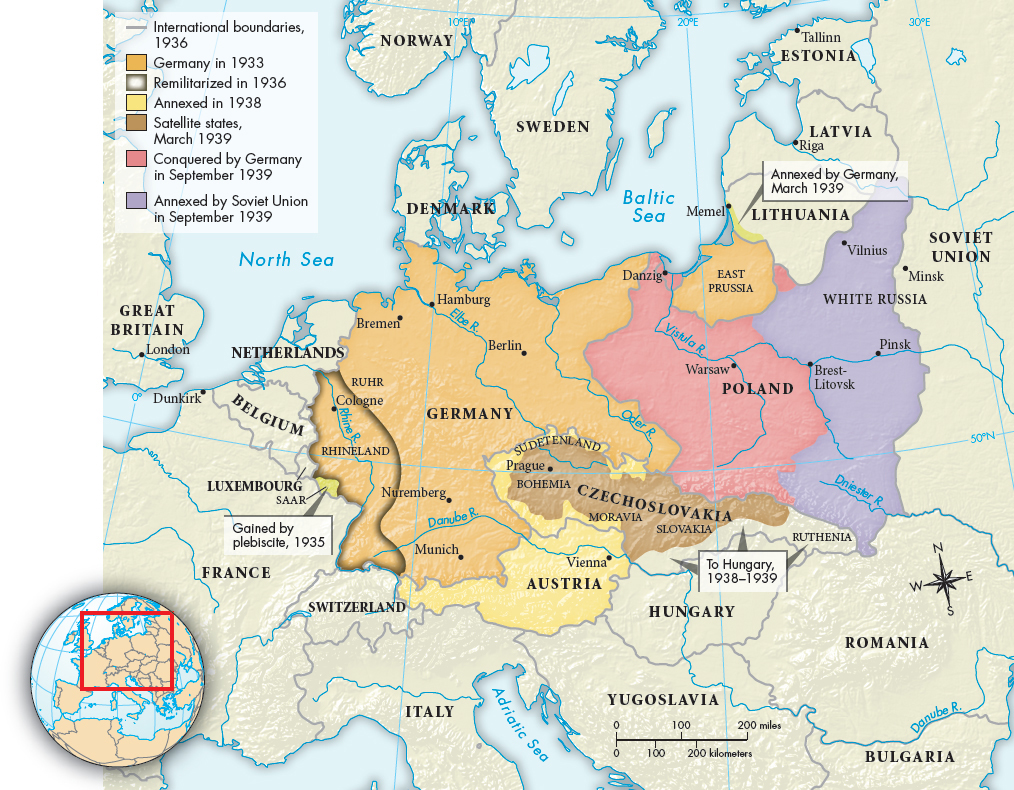Understanding World Societies:
Printed Page 936
Chapter Chronology
Aggression and Appeasement, 1933–1939

Italy’s Ethiopian Campaign, 1935–1936
After Germany’s economic recovery and Hitler’s success in establishing Nazi control of society, he turned to the next item on his agenda: aggressive territorial expansion. Germany’s withdrawal from the League of Nations in October 1933 indicated its determination to rearm. When in March 1935 Hitler established a general military draft and declared the “unequal” Versailles treaty disarmament clauses null and void, leaders in Britain, France, and Italy issued a rather tepid joint protest and warned him against future aggressive actions.
But the emerging united front against Hitler quickly collapsed. Britain adopted a policy of appeasement, granting Hitler everything he could reasonably want (and more) in order to avoid war. British appeasement, which practically dictated French policy, had the support of many powerful British conservatives who, as in Germany, underestimated Hitler. The British people, still horrified by the memory, the costs, and the losses of the First World War, generally supported pacifism rather than war.
In March 1936 Hitler suddenly marched his armies into the demilitarized Rhineland, violating the Treaties of Versailles and Locarno. France would not move without British support, and Britain refused to act. As Britain and France opted for appeasement and the Soviet Union watched all developments suspiciously, Hitler found powerful allies. In October 1936 Italy and Germany established the so-called Rome-Berlin Axis. Japan, which wanted support for its occupation of Manchuria, also joined the Axis alliance (see “Japan Against China” in Chapter 29).
At the same time, Germany and Italy intervened in the Spanish Civil War (1936–1939), where their support helped General Francisco Franco’s Fascist movement defeat republican Spain. Republican Spain’s only official aid in the fight against Franco came from the Soviet Union.
In late 1937 Hitler moved forward with his plans to crush Austria and Czechoslovakia as the first step in his long-contemplated drive to the east for living space. By threatening Austria with invasion, Hitler forced the Austrian chancellor in March 1938 to put local Nazis in control of the government. The next day German armies moved in unopposed, and Austria became two provinces of Greater Germany (Map 30.1).

MAP 30.1The Growth of Nazi Germany, 1933–1939Until March 1939 Hitler brought ethnic Germans into the Nazi state; then he turned on the Slavic peoples, whom he had always hated. He stripped Czechoslovakia of its independence and prepared for an attack on Poland in September 1939.
Simultaneously, Hitler demanded that the pro-Nazi, German-speaking territory of western Czechoslovakia — the Sudetenland — be turned over to Germany. Democratic Czechoslovakia was prepared to defend itself, but appeasement triumphed again. In September 1938 British prime minister Arthur Neville Chamberlain (1869–1940) flew to Germany three times in fourteen days. In these negotiations Chamberlain and the French agreed with Hitler that the Sudetenland should be ceded to Germany immediately. Sold out by the Western powers, Czechoslovakia gave in.
Hitler’s armies occupied the remainder of Czechoslovakia in March 1939. This time, there was no possible rationale of self-determination for Nazi aggression. When Hitler used the question of German minorities in Danzig as a pretext to confront Poland, Chamberlain declared that Britain and France would fight if Hitler attacked his eastern neighbor. Hitler did not take these warnings seriously and pressed on.
Then, in an about-face that stunned the world, sworn enemies Hitler and Stalin signed a nonaggression pact in August 1939. Each dictator promised to remain neutral if the other became involved in war. An attached secret protocol divided eastern Europe into German and Soviet zones “in the event of a political and territorial reorganization.”8 Stalin agreed to the pact for three reasons: he distrusted Western intentions, he needed more time to build up Soviet industry and military reserves, and Hitler offered territorial gain.
For Hitler, everything was now set. On September 1, 1939, the Germans attacked Poland from three sides. Two days later, Britain and France, finally true to their word, declared war on Germany. The Second World War had begun.
What role did economic factors play both in Hitler’s rise to power and his popularity once in power?

